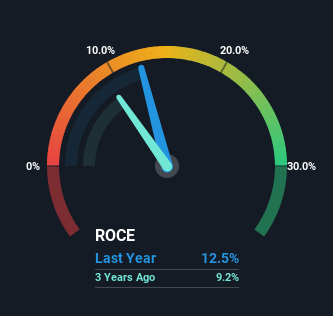- United States
- /
- Media
- /
- NYSE:WLY
John Wiley & Sons (NYSE:WLY) Shareholders Will Want The ROCE Trajectory To Continue
Finding a business that has the potential to grow substantially is not easy, but it is possible if we look at a few key financial metrics. Ideally, a business will show two trends; firstly a growing return on capital employed (ROCE) and secondly, an increasing amount of capital employed. Basically this means that a company has profitable initiatives that it can continue to reinvest in, which is a trait of a compounding machine. So when we looked at John Wiley & Sons (NYSE:WLY) and its trend of ROCE, we really liked what we saw.
What Is Return On Capital Employed (ROCE)?
For those who don't know, ROCE is a measure of a company's yearly pre-tax profit (its return), relative to the capital employed in the business. The formula for this calculation on John Wiley & Sons is:
Return on Capital Employed = Earnings Before Interest and Tax (EBIT) ÷ (Total Assets - Current Liabilities)
0.13 = US$236m ÷ (US$2.6b - US$717m) (Based on the trailing twelve months to January 2025).
Therefore, John Wiley & Sons has an ROCE of 13%. On its own, that's a standard return, however it's much better than the 10.0% generated by the Media industry.
See our latest analysis for John Wiley & Sons

Above you can see how the current ROCE for John Wiley & Sons compares to its prior returns on capital, but there's only so much you can tell from the past. If you'd like, you can check out the forecasts from the analysts covering John Wiley & Sons for free.
What Does the ROCE Trend For John Wiley & Sons Tell Us?
John Wiley & Sons has not disappointed in regards to ROCE growth. We found that the returns on capital employed over the last five years have risen by 37%. That's not bad because this tells for every dollar invested (capital employed), the company is increasing the amount earned from that dollar. Speaking of capital employed, the company is actually utilizing 25% less than it was five years ago, which can be indicative of a business that's improving its efficiency. A business that's shrinking its asset base like this isn't usually typical of a soon to be multi-bagger company.
In Conclusion...
In summary, it's great to see that John Wiley & Sons has been able to turn things around and earn higher returns on lower amounts of capital. And with a respectable 64% awarded to those who held the stock over the last five years, you could argue that these developments are starting to get the attention they deserve. Therefore, we think it would be worth your time to check if these trends are going to continue.
Like most companies, John Wiley & Sons does come with some risks, and we've found 3 warning signs that you should be aware of.
While John Wiley & Sons may not currently earn the highest returns, we've compiled a list of companies that currently earn more than 25% return on equity. Check out this free list here.
New: Manage All Your Stock Portfolios in One Place
We've created the ultimate portfolio companion for stock investors, and it's free.
• Connect an unlimited number of Portfolios and see your total in one currency
• Be alerted to new Warning Signs or Risks via email or mobile
• Track the Fair Value of your stocks
Have feedback on this article? Concerned about the content? Get in touch with us directly. Alternatively, email editorial-team (at) simplywallst.com.
This article by Simply Wall St is general in nature. We provide commentary based on historical data and analyst forecasts only using an unbiased methodology and our articles are not intended to be financial advice. It does not constitute a recommendation to buy or sell any stock, and does not take account of your objectives, or your financial situation. We aim to bring you long-term focused analysis driven by fundamental data. Note that our analysis may not factor in the latest price-sensitive company announcements or qualitative material. Simply Wall St has no position in any stocks mentioned.
About NYSE:WLY
John Wiley & Sons
A publisher, provides authoritative content, data-driven insights, and knowledge services for the advancement of science, innovation, and learning in the United States, China, the United Kingdom, Japan, Australia, and internationally.
Established dividend payer with moderate growth potential.
Similar Companies
Market Insights
Community Narratives



